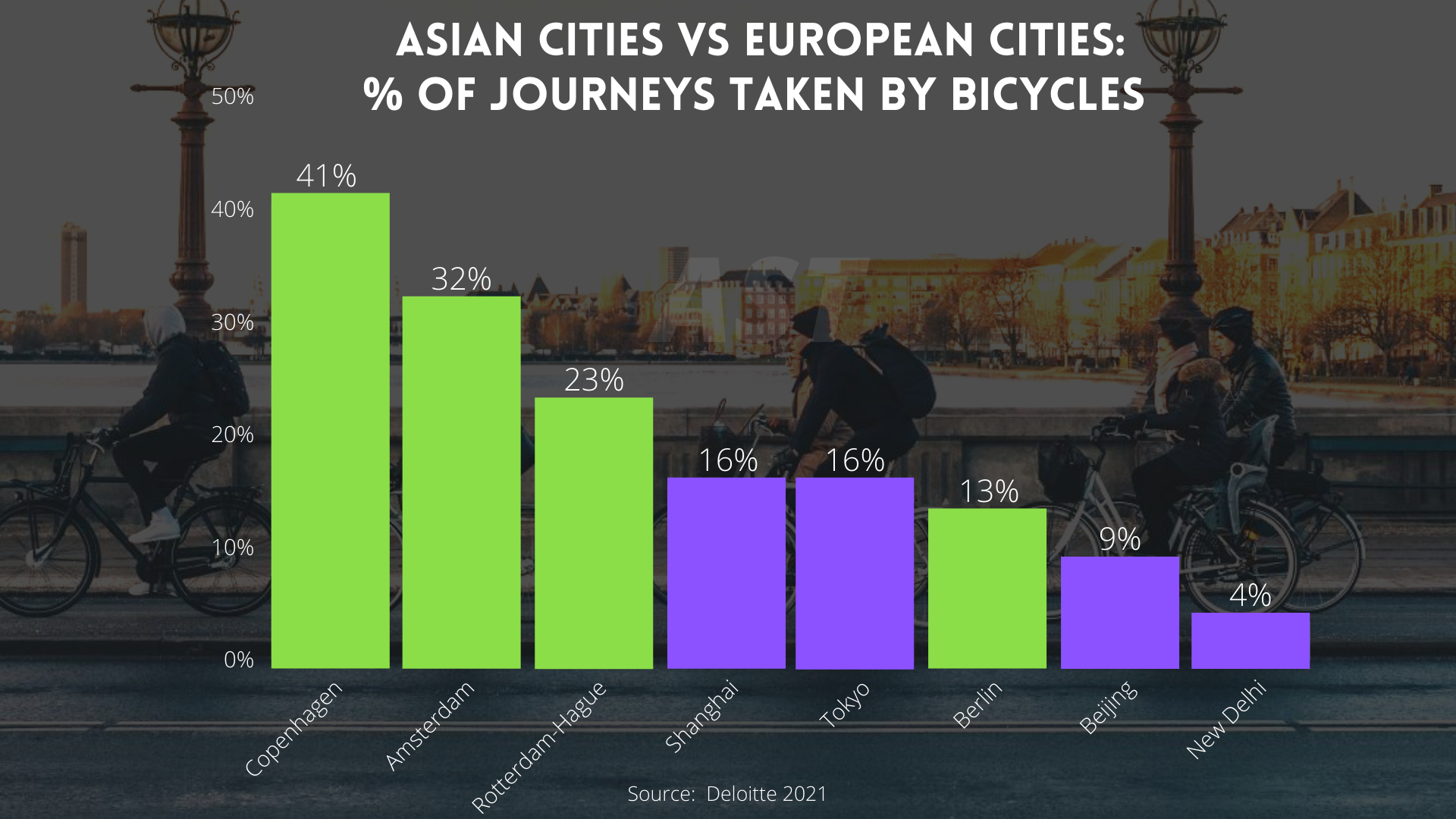
Photo Credit: Paolo Candelo / Unsplash
Cycling is one of the most prevalent sports in the world. According to the World Economic Forum, over 50% of the global population knew how to ride a bike back in 2015 and the number has rapidly grown in recent years due to Covid. By 2050, over five billion bikes will be in use globally.
Cycling has evolved so much over the years that it has shifted from being a form of transportation, to a leisure activity and to a sport with many variations including road biking, mountain biking, virtual biking and spinning. More and more cities are encouraging cycling through initiatives like the “UCI Bike City label”.
In this article, we will discuss what are the opportunities and challenges of the emerging cycling business and how Asia offers favorable conditions and opportunities for cycling to grow.
First things first – addressing the bike and equipment shortage
People’s determination to stay active under the pandemic resulted in a huge exercise boom around the world with cycling being one of the fastest-growing segments. As a result, the global bicycle market size is expected to rise at a rate of 6.1% CAGR, from US$65 billion in 2019 to US$ 147 billion by 2027 according to a research by Fortune Business Insights.
2020 Strava’s report shows that the popularity of cycling has massively outgrown running in 2020. In 2021, cyclists logged a total ride distance of 10 billion kilometers with 480 billion meters of elevation on Strava globally from Q4 2020 to Q3 2021.
Additionally, in 2020 Google Maps recorded a 69% increase in cycling direction searches, doubled the number of bicycle repair services searches and added over 150,000 km of new bike routes to Google Maps.
Moreover, we saw the explosion of electric bikes around the world owing to the increasing awareness of health as well as concerns over carbon emission.
These activity records demonstrate the massive growth of cycling, yet, this significant spike in activity led to a severe problem: A SHORTAGE of bikes (both classic and electric) and equipment (derailleurs, wheels, etc) as manufacturers struggled to keep up with the demand. The drastic surge in bicycle demand was unexpected and the supply chain crisis that occurred under the pandemic taught us a lesson that supply chain dependence on a single country or factory is extremely risky. For example, many leading cycling brands had delivery delays of up to 12 months, impacting reputation and sales.
Therefore, the first step for companies to monetize the growing demand for cycling is to tailor strategies that de-risk the supply chain and ensure a stable supply.
(Read our insights on how to optimize your supply chain and don’t hesitate to reach out for any questions related to supply chain and product innovation)
Technology drives cycling forward
Cycling is going through a stage of significant technological transformation. A report by Deloitte regarded cycling tech as one of the Top 10 global technology trends in 2020. As we have previously mentioned, Cycling Tech is an emerging segment that investors should keep an eye on.
There are now more tech-based accessories, devices and software that are designed for both pro and amateur cyclists to improve the rider experience in terms of speed, technique, safety, comfort and performance.
AST spoke to Eric DeGolier, Founder of a fast-accelerating cycling tech company, Body Rocket, a device that provides real-time aerodynamic data for cyclists and triathletes. Eric shared what motivates him everyday:
“We want to unlock the full potential of a cyclist’s aerodynamics. While the sport has seen a huge focus on all things aero, the rider’s body dwarfs any other potential gains and there is still no good consumer solution for this. Body Rocket’s direct-force drag meter is solving that by making aerodynamic drag measurement as easy as using a power meter.”
He also mentioned how cycling tech has evolved over the years and how tech is transforming coaching and training in pro-cycling:
“Heart rate, and then power, completely changed the way we train and race. Now there’s a wide range of technologies coming to market that promise to change things once again. The effects of each tech can be much broader than they first appear. Power meters, for example, completely changed the coaching industry. 25 years ago your coach was almost certainly in the same city, a coaching session involved a stopwatch and a flat stretch of road, and hardly anyone did it for a living. Today thousands of people successfully earn a living in coaching, because the currency of coaching is now an easily shareable power file. I like to look at new tech through that lens, and ask: how will this data affect other roles in our industry?”

Eric DeGolier, Founder of Body Rocket
Innovation and digital technologies are bringing new dimensions to cycling and we believe that this sector will continue to explode which offers lucrative opportunities for investors.
The narrowing gender gap in cycling
Things are finally progressing for diversity in cycling in recent years. An article by Cycling Weekly highlighted some key stats: Strava’s 2020 Year in Sport review cited a 45% increase in cycling activities uploaded by women aged 18-29, and a 25% rise from women of other age groups compared to a 10% increase in men’s activities while Zwift’s women’s user base grew by 2.8x versus 2.3x for men from 2020 – 2022.
With more women getting into cycling, it is opening new doors for companies to capitalize on this growing consumer segment (especially young female riders) and they are developing women’s specific bikes, apparel and gear.
There is also an increase in female representation in professional cycling. The Tour De France, the world’s most renowned cycling race will finally include a race for female cyclists dubbed Tour De France Femmes which will officially debut in July 2022. It is unprecedented in the history of Women’s professional cycling in terms of the race format, broadcast exposure and prize money.
“Women’s cycling is part of this momentum of modernity, equity and humanism.”
Magalie Lavenu
Brands are realizing the value of women’s cycling. Strava recently announced an Official Multi-Year Partnership with Tour de France and Tour de France Femmes avec Zwift. One of Strava’s key missions is to bolster the ecosystem of women’s cycling. Zwift has also increased its investment in women’s cycling by signing a deal to become the title sponsor of the UCI’s race Paris-Roubaix Femmes.
Magalie Lavenu, Strategy & Development Director of the AG2R CITROËN TEAM (a UCI WORLD TOUR team), believes that the increasing popularity of women’s pro-cycling will enable the sport to grow thus it is crucial to embrace diversity in cycling: “A development plan for women’s cycling has been initiated by the UCI for some years, involving all cycling families. It is essential to see women’s professional cycling emerge.”
“Sport is an important lever for the emancipation of women. It reinforces self-esteem, well-being, autonomy and responsibility, in a world where women need to be encouraged to assert themselves more. If equality of rights between men and women is a condition for the development of human societies, the same applies to the emergence of women’s sport, which promotes the development of sport as a whole. Women athletes will inspire the young generations, both men and women, who will recognize themselves in the values it carries.” said Lavenu.
In addition, more Asian women are entering pro-cycling: Sarah Lee from Hong Kong who won a Bronze medal at the London 2012 Olympics (Keirin) and at the Tokyo 2020 Olympics (Sprint). Southeast Asia’s rising stars include Chelsie Tan from Singapore who joined Team BikeExchange Jayco and Nur Alia from Malaysia who will participate in the Canyon-SRAM race. There is also China Liv Pro Cycling, the first and only women’s professional cycling team in Asia which was founded in 2006.
We are seeing a positive shift and the increasing exposure and sponsorship money in events and media are propelling the growth of women’s cycling and will create opportunities for sponsors and broadcasters.
Massive opportunities in Asia
Asia is the fastest-growing region in the global bicycle market and has emerged as a dominant market with a revenue share exceeding 30% in 2021 according to Grandview Research.
Cities in Asia such as Beijing, Shanghai and Tokyo are some of the top cities globally where citizens use bicycles to commute. Although the percentages of journeys taken by bicycles are higher in Europe, the cycling population in these Asian cities is higher given their large population.
We previously highlighted the importance and benefits of optimizing outdoor spaces to get citizens active including creating a bike-friendly environment as a key element of urban planning. Many cities in Southeast Asia and India are still undergoing urbanization, and with that, the cycling population in Asia will further increase.

Favorable conditions including a huge biking population, rising awareness of health and fitness among high-spending consumers, the increasing number of cycling events and government policies like the National Fitness Program in China will further drive the cycling market in Asia and boost the consumption of other sub-sectors of cycling.
Eric DeGolier sees many opportunities in the region and thinks there is still room to grow:
“The Asian market has more potential for growth than anywhere in the world. I believe demand will grow organically over time, but I’m always looking for the kind of turning point events like America had when Greg Lemond won the Tour, or like Great Britain had with their dominance of the track events at the London Olympics, that can make a country suddenly fall in love with the sport.”
While the potential is huge while, the challenge of entering Asia’s highly fragmented market requires insights, planning and strong relationships.
Want to capitalize on the growth of cycling in Asia? Connect with us to learn more.







